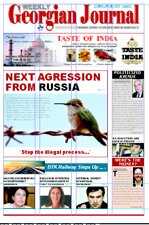Ishkhani Process in Progress
25 April, 2013
 Georgian Journal contacted Irine Giviashvili, art historian, a research fellow of Giorgi Chubinashvili National Center of Georgian Art History and Monument Protection, who resides in Ireland and asked her to talk about the negotiations between Georgian and Turkish sides about the faults of restoration process and future development.
Georgian Journal contacted Irine Giviashvili, art historian, a research fellow of Giorgi Chubinashvili National Center of Georgian Art History and Monument Protection, who resides in Ireland and asked her to talk about the negotiations between Georgian and Turkish sides about the faults of restoration process and future development.“I was among the Georgian team who visited Ishkani on April 17. The current background of the process is that the restoration of the 11th c. Cathedral has started with many defects. Deputy Minister of Culture Ms. Marine Mizandari met with her Turkish colleague Mr. Ozgur Ozalen in Ankara and they agreed that the Georgian team will arrive to meet with Turkish colleagues to examine and discuss the problems of restoration. Georgian team was led by architectural restorer Merab Bochoidze, general director of the National Agency for Protection of Monuments, and other professionals from the same office; Prof. J.Gagoshidze, P.Gaprindashvili, G.Gagoshidze and B. Matsaberidze represented Ministry of Culture and M. Buchukuri - the patriarchate of Georgia. Turkish side was represented by the director of Culture and Turism of Artvin province H.Atesand, head of the Erzerum office of Monuments protection Mr. S.Bakir and by the representatives of the firm ‘Anfora Mimarlik Restorasyon’, who prepared the project of Ishkhani restoration and arrived in Ishkhanfrom Istanbul.”
Q. What can you say about the final stage of the agreement and how both sides see the development of events?
A. Turkish side declared that the 400 day is not a deadline for the whole restoration of the building; it is only the first stage of the project. Meanwhile; the engineering project is on its way of completion. Only after the stability of the walls and the basement is checked, it will be clear what the chances of restoring the damaged arches, vaults and the conch of the building. The newly discovered 11th century flooring was a surprise for both, Georgian and Turkish scholars, as far as it was buried under the earth for about two hundred years and its archeological survey has never been done. These new circumstances must be taken into an account.”
Q. There were more discoveries in Ishkhani and Oski churches. What kind of findings are they?
A. There are more new discoveries; it is extremely interesting and valuable to identify the previous layers of the church. From the book by Giorgi Merchule about the Life of Holy Father Grigol Khandzteli, we know that the Church in Ishkhani went through several reconstructions. The first one was in the 7th c, second - in 9th c. What we see here is mostly the 10th - 11th cc., as the inscriptions indicate.
Tranches dug during recent weeks, show new valuable information. It needs a precise documentation and conservation along with its further archeological survey. These details, mostly visible on the western facade, as well as in many different places of the building, have to be preserved, retaining their authentic face. It has to be excavated under the supervision of the expert of this particular subject. Turkish Art Historian, Dr. Mine Kadiroglu has written a monograph on Ishkani. I think that the Turkish firm has to use that unique chance and invite Dr. Mine Kadiroglu to expertize the building, its archeological and architectural layers. Until our visit in Ishkani, there was no systematic recording of findings. We hope that the Turkish team will take into account the complexity of the monument; and our recommendations will also be helpful.”





















































